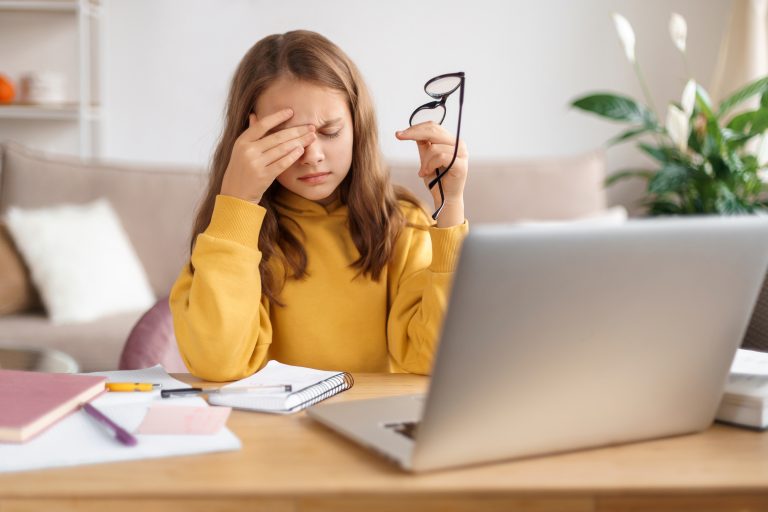When we exercise, we use up the energy in our muscles, causing them to feel fatigued and spent. Our brain works similarly. Though not a muscle, the brain is a part of our body that can tire out the more it’s used, and when it tires out it needs rest and recuperation in order to recover and function properly.
This is especially true for those that struggle with ADHD and other attention related issues. ADHD requires a lot of mental energy. Failing to respond to that energy correctly can lead to many issues, one of which is known as “ADHD Burnout.”
Understanding ADHD Burnout
First off, it’s important to understand that burnout isn’t an unnatural thing, or something limited to ADHD. Any time we feel overworked or overwhelmed, or where our mental resources are being used too much throughout the day, we can struggle with brain fatigue that is often called “Burnout.”
But children – and adults – with ADHD tend to struggle with this a lot more. That is because the minds of those with ADHD are constantly working. They’re struggling with:
- Pushing themselves too hard
- Trying to manage their attention
- Jumping between different topics and ideas
- Being scolded or reprimanded for their behaviors
- Navigating social issues
- Coping with emotional and cognitive challenges
This is especially challenging for children, who have yet to develop as many healthy coping strategies and are still trying to learn mental and emotional resilience. Children also have developing brains and are constantly learning, both in school and at home, which means their brains are already being used extensively even without the challenges of ADHD.
What Are the Symptoms of ADHD Burnout?
What we often called feeling “overwhelmed” shares many of the same symptoms that we expect to see in ADHD burnout. In children, we may notice:
- Increased Fatigue
- Irritability When Faced with Challenges
- Mood Swings
- Poor Academic Performance
- Unexpected Further Difficulty in Paying Attention
It can be difficult to notice when a child is experiencing ADHD burnout, so parents need to listen to what their child says and how they are responding to challenges or tasks to notice when they may be feeling stressed or unable to cope with life demands.
What Can Be Done to Reduce ADHD Burnout?
Addressing both ADHD and some of the mental health symptoms associated with ADHD (poor coping skills, anxiety, and stress) are an important part of reducing ADHD burnout. Other things you or your child can do include:
- Give Yourself Alone Time
One of the best ways to address burnout in all forms is to unplug and find time to do nothing. Like resting a muscle, you need a few moments of quiet, with no technology, no commercialization, and no academic or social demands. Even if your child needs to do their homework, for example, this quiet and comfortable time can help them recoup some of the mental energy they need to thrive.
- Do Things You Love
Similarly, another technique that can also be helpful is to explore hobbies and activities that we find fulfilling or relaxing. Taking a walk, listening to music, and even intentional mediation can lend us those moments of respite our burnt-out brains have been searching for. It may seem contradictory that focusing or concentrating on another activity will allow us to recuperate, but finding the right sensory pastime or distraction can often be the fulfillment our minds need.
It can be all to easy to view these activities are unnecessary or unproductive when compared with schoolwork or professional avenues. Remembering to, “prioritize rest and relaxation, and avoid over-scheduling yourself,” though has to hold a priority in our lives.
- Create Healthy Routines.
It also cannot be understated that our minds need healthy routines. Examining our sleep schedules and altering them for recovery is a good step. Similar to depression, taking a shower, refreshing our hygiene and maintaining a presentation for just ourselves allows us to maintain a healthy level of sustainability.
ADHD Burnout is not something that can be easily managed when we are focused on being productive. It is a state that was acquired by our consistent pursuit of production, and therefore must be tackled with introspection and relaxation.
For children, routines make it easier for them to get relief from some of the stresses and pressures of managing their lives. They help children learn to cope as well, because knowing what’s coming next helps them feel safe and cared for. Fewer pressures and better coping means less risk of burnout from ADHD.
Next Steps – Talk to a Therapist for ADHD
ADHD is a lifelong condition. But there are many ways to create an environment for your child that is more manageable. If you would like to help your child cope with ADHD burnout, contact our therapists and counselors at Right Path Counseling, today.

